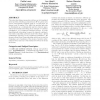Free Online Productivity Tools
i2Speak
i2Symbol
i2OCR
iTex2Img
iWeb2Print
iWeb2Shot
i2Type
iPdf2Split
iPdf2Merge
i2Bopomofo
i2Arabic
i2Style
i2Image
i2PDF
iLatex2Rtf
Sci2ools
SAC
2009
ACM
2009
ACM
On a discretizable subclass of instances of the molecular distance geometry problem
The molecular distance geometry problem can be formulated as the problem of finding an immersion in R3 of a given undirected, nonnegatively weighted graph G. In this paper, we discuss a set of graphs G for which the problem may also be formulated as a combinatorial search in discrete space. This is theoretically interesting as an example of “combinatorialization” of a continuous nonlinear problem. It is also algorithmically interesting because the natural combinatorial solution algorithm performs much better than a global optimization approach on the continuous formulation. We present a Branch and Prune algorithm which can be used for obtaining a set of positions of the atoms of protein conformations when only some of the distances between the atoms are known. Categories and Subject Descriptors J.3 [Life and medical sciences]: Biology and genetics; G.2.1 [Combinatorics]: Combinatorial algorithms; G.2.2
Applied Computing | Combinatorial | Continuous Nonlinear Problem | Distance Geometry Problem | SAC 2009 |
| Added | 19 May 2010 |
| Updated | 19 May 2010 |
| Type | Conference |
| Year | 2009 |
| Where | SAC |
| Authors | Carlile Lavor, Leo Liberti, Antonio Mucherino, Nelson Maculan |
Comments (0)

